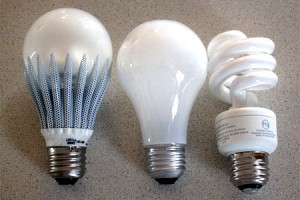Cleantech Approach conducted research in October 2009 comparing solid state lighting to traditional incandescent bulbs, halogen bulbs, compact fluorescent bulbs (CFL), linear fluorescent bulbs (LF), and metal halide bulbs (MF). The sustainable solutions research company took into consideration prices of bulbs, energy costs, performance, bulb life time, and cost of operation of each bulb. The search favored solid state lighting in almost every category.  Solid state lighting outperformed all of the traditional lighting fixtures in performance and payback time, with the exception of CFLs. The electricity costs of incandescent bulbs are 4 – 6 times higher, and the bulbs last approximately 4% as long as LED lighting fixtures. According to the research, the energy costs of halogen bulbs are 4 times higher, and the bulbs only last 5% as long. Payback time and cost of operation of both bulbs is similar. The cost of operation of the fixtures is about 8 – 15 times greater than LED alternatives, and the payback times range from 1.7 – 3.5 years. Linear fluorescent and metal halide bulbs also have similar performance results. Both energy costs are similar, but their lifetimes are 12% – 25% as long as LED lighting. Their costs of operation are also significantly higher than LED fixtures. CFLs are a little different. CFLs have been under the “spotlight” because they give off UV rays and contain mercury. LEDs outperformed CFLs in energy costs, bulb lifetime, and cost of operation. CFLs only outperformed LEDs in payback time because of the current price of CFLs in comparison to the current prices of LEDs. LEDs are the better alternative because they do not contain mercury, consume less power, and last longer. According to CTA’s research, “Consistent with the Department of Energy’s forecasts, we expect to see warm white LED brightness and efficacy improvements of 14% per annum through 2015, which should serve to make LEDs increasingly compelling solutions compared to conventional technologies, with regard to CFL lighting options.” We hope that the conclusions from CTA’s research help consumers choose solid state lighting as a sustainable alternative.
Solid state lighting outperformed all of the traditional lighting fixtures in performance and payback time, with the exception of CFLs. The electricity costs of incandescent bulbs are 4 – 6 times higher, and the bulbs last approximately 4% as long as LED lighting fixtures. According to the research, the energy costs of halogen bulbs are 4 times higher, and the bulbs only last 5% as long. Payback time and cost of operation of both bulbs is similar. The cost of operation of the fixtures is about 8 – 15 times greater than LED alternatives, and the payback times range from 1.7 – 3.5 years. Linear fluorescent and metal halide bulbs also have similar performance results. Both energy costs are similar, but their lifetimes are 12% – 25% as long as LED lighting. Their costs of operation are also significantly higher than LED fixtures. CFLs are a little different. CFLs have been under the “spotlight” because they give off UV rays and contain mercury. LEDs outperformed CFLs in energy costs, bulb lifetime, and cost of operation. CFLs only outperformed LEDs in payback time because of the current price of CFLs in comparison to the current prices of LEDs. LEDs are the better alternative because they do not contain mercury, consume less power, and last longer. According to CTA’s research, “Consistent with the Department of Energy’s forecasts, we expect to see warm white LED brightness and efficacy improvements of 14% per annum through 2015, which should serve to make LEDs increasingly compelling solutions compared to conventional technologies, with regard to CFL lighting options.” We hope that the conclusions from CTA’s research help consumers choose solid state lighting as a sustainable alternative.
